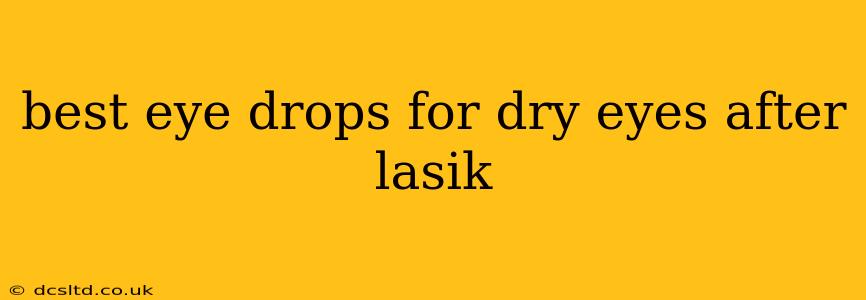LASIK surgery, while offering remarkable vision correction, often leads to temporary—and sometimes persistent—dry eyes. The procedure disrupts the delicate balance of your tear film, leaving your eyes feeling gritty, itchy, and uncomfortable. Choosing the right eye drops can significantly alleviate these symptoms and contribute to a smoother recovery. This guide explores the best eye drop options for dry eyes post-LASIK, addressing common questions and concerns.
What Causes Dry Eyes After LASIK?
During LASIK, the surgeon creates a flap in the cornea, the eye's outermost layer. This process can temporarily disrupt the nerves that control tear production and the meibomian glands that secrete oils essential for a stable tear film. Reduced tear production and altered tear composition result in dry eye symptoms. The dryness is often most pronounced in the first few weeks post-surgery, but for some, it can persist longer.
What are the Different Types of Eye Drops for Dry Eyes After LASIK?
Several types of eye drops can help manage dry eyes post-LASIK. Your ophthalmologist will likely recommend specific options based on your individual needs and the severity of your symptoms. However, here are some common categories:
Artificial Tears:
These are the most commonly recommended eye drops for dry eyes after LASIK. They lubricate the eye's surface, mimicking the natural components of tears. Look for preservative-free options to minimize potential irritation. Many brands are available over-the-counter, but always check with your doctor before using any new eye drops.
Restasis (Cyclosporine):
This prescription medication targets the underlying cause of dry eye by increasing tear production. It's particularly helpful for those experiencing persistent dry eye symptoms after LASIK. It's not a quick fix; it takes several weeks to see noticeable improvements.
Xiidra (Lifitegrast):
Another prescription medication, Xiidra works by reducing inflammation in the eyes, which often contributes to dry eye disease. It might be a suitable option if artificial tears aren't sufficient.
Gel-Based Lubricants:
These provide longer-lasting lubrication compared to standard artificial tears. They are usually best applied at bedtime to prevent blurry vision during the day.
What Eye Drops Should I Avoid After LASIK?
Certain eye drops should be avoided after LASIK surgery to prevent complications. These include:
- Eye drops containing preservatives: These can irritate the delicate corneal surface during healing.
- Eye drops with vasoconstrictors (e.g., Visine): These can temporarily reduce redness but can interfere with the healing process.
- Steroid eye drops (unless prescribed by your doctor): While helpful for certain eye conditions, steroids can increase the risk of infection and delay healing after LASIK.
How Often Should I Use Eye Drops After LASIK?
The frequency of eye drop use depends on the severity of your dry eyes and the type of drops you’re using. Your ophthalmologist will provide specific instructions. Initially, you may need to use them very frequently, perhaps every hour or two. As your eyes heal, you may be able to gradually reduce the frequency.
Are There Any Side Effects of Using Eye Drops After LASIK?
While generally safe, some individuals may experience minor side effects from eye drops such as temporary blurred vision, stinging, or burning. If you experience any significant side effects, contact your ophthalmologist.
Can I Use Over-the-Counter Eye Drops After LASIK?
Many over-the-counter artificial tears are safe to use after LASIK, particularly preservative-free options. However, always consult your ophthalmologist before using any new eye drops. They can advise on the most appropriate type and frequency of use.
How Long Will I Need to Use Eye Drops After LASIK?
The duration of eye drop use varies depending on individual healing and the severity of dry eye symptoms. Some people might only need them for a few weeks, while others may require them for several months or even longer. Your ophthalmologist will monitor your progress and adjust the treatment plan as needed.
What other treatments are available for dry eyes after LASIK?
In addition to eye drops, your doctor might suggest other treatments such as warm compresses, punctal plugs (to reduce tear drainage), or lifestyle changes to manage dry eyes more effectively.
Remember, this information is for general knowledge and does not constitute medical advice. Always consult your ophthalmologist for personalized guidance regarding the best eye drops and dry eye management strategies following LASIK surgery. They can assess your specific situation and recommend the most appropriate treatment plan for optimal comfort and healing.
